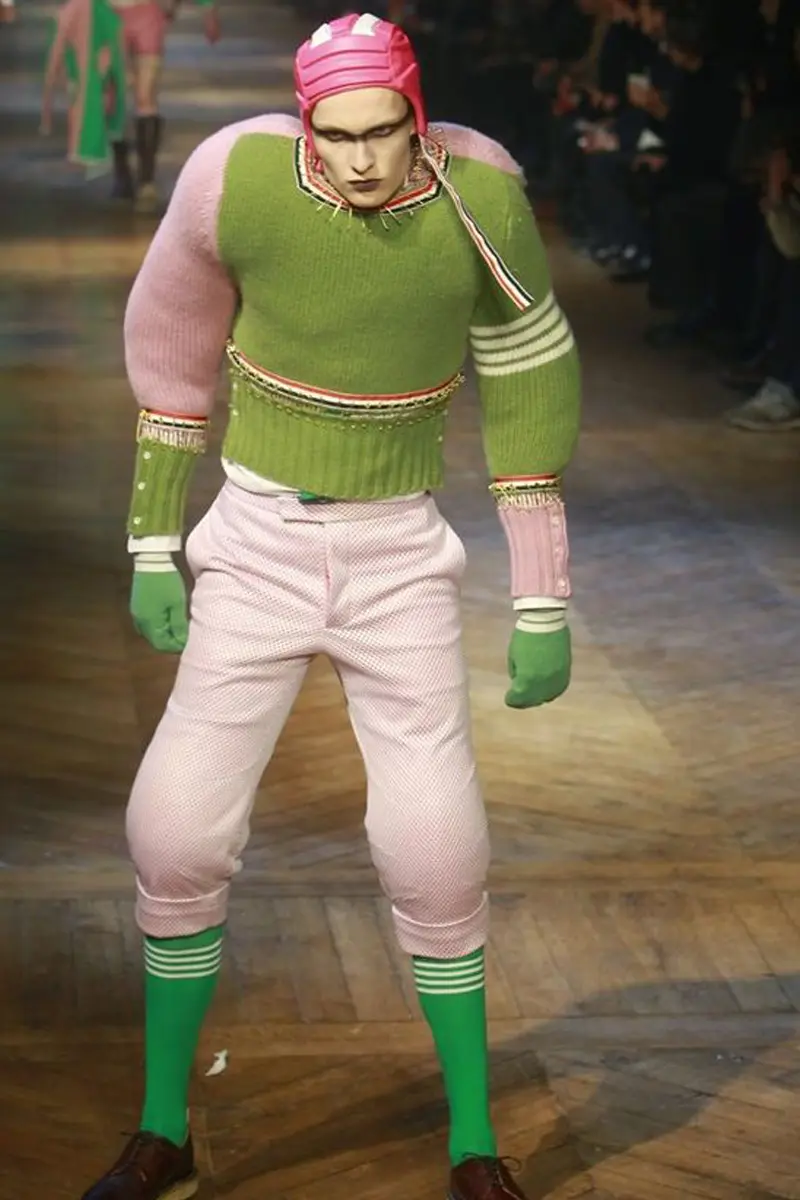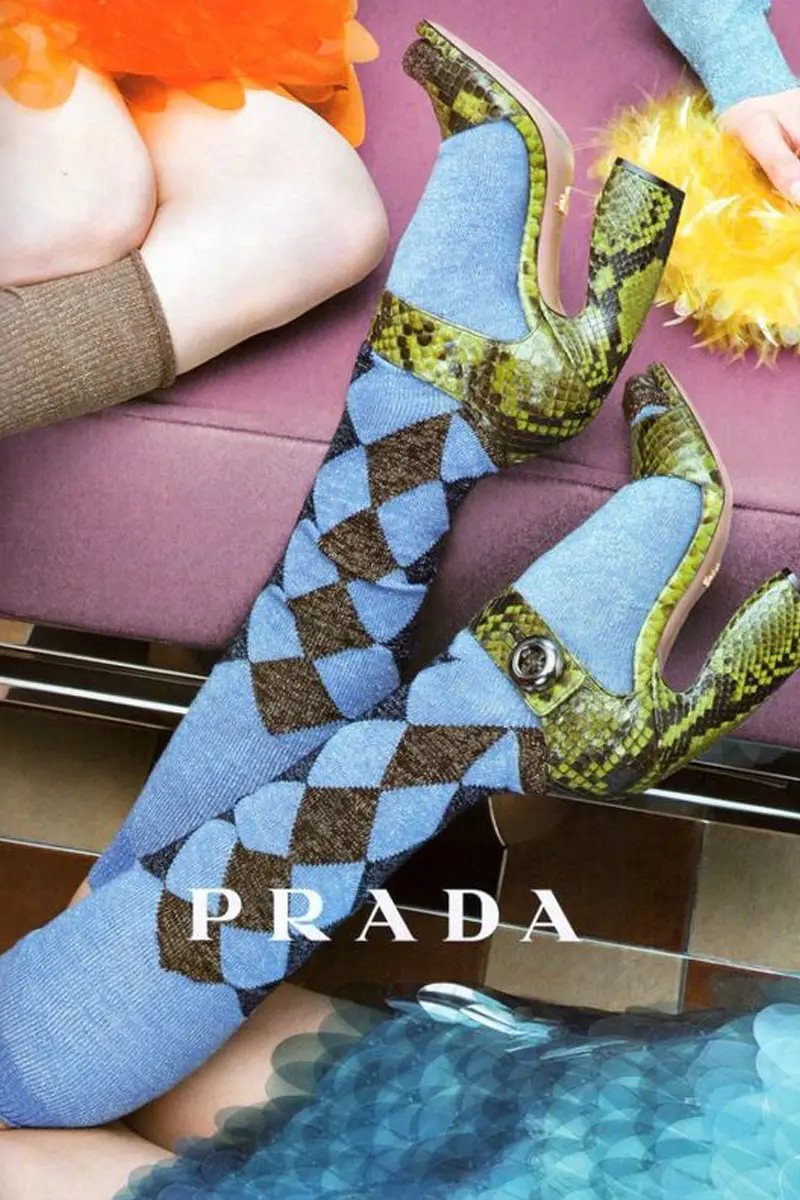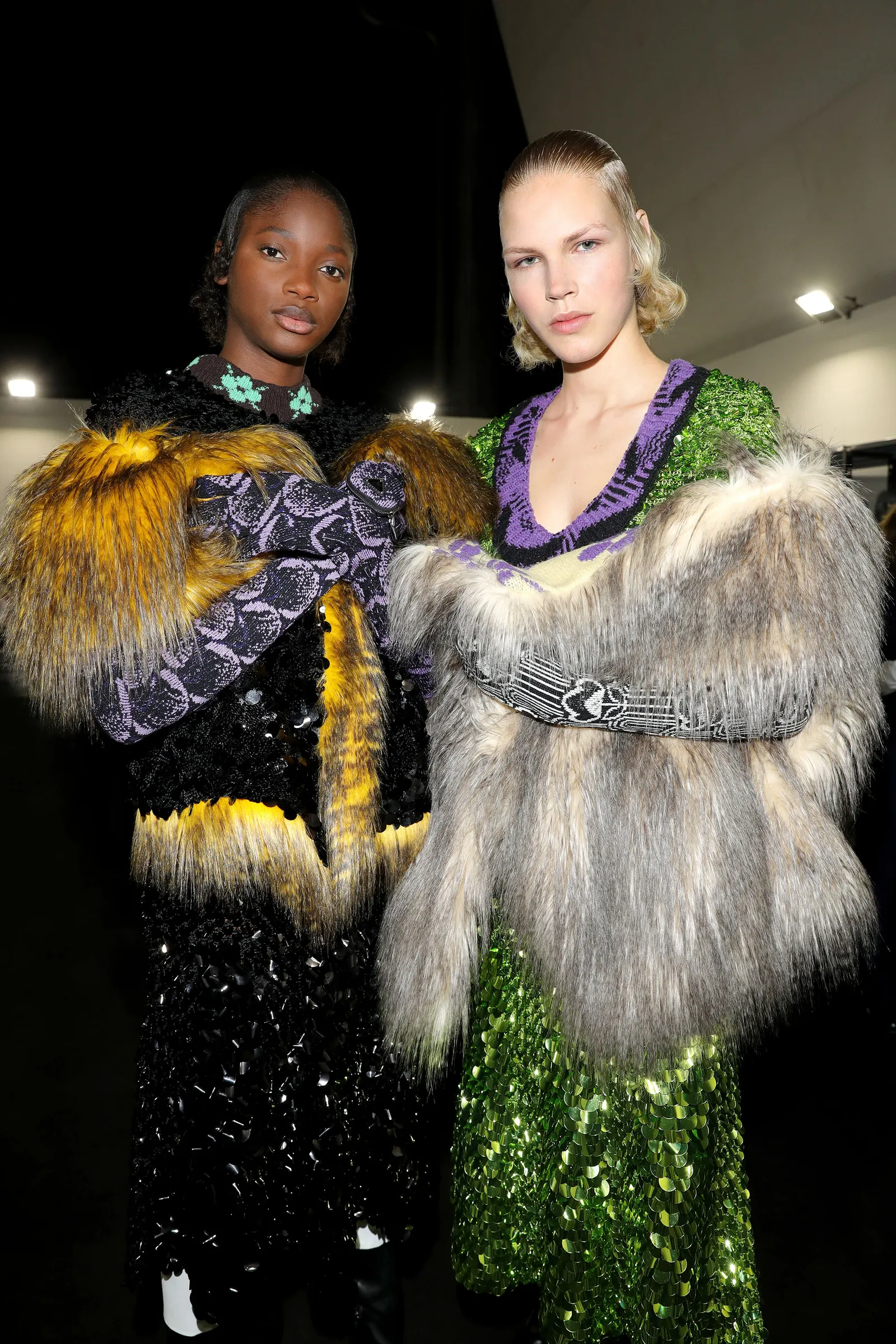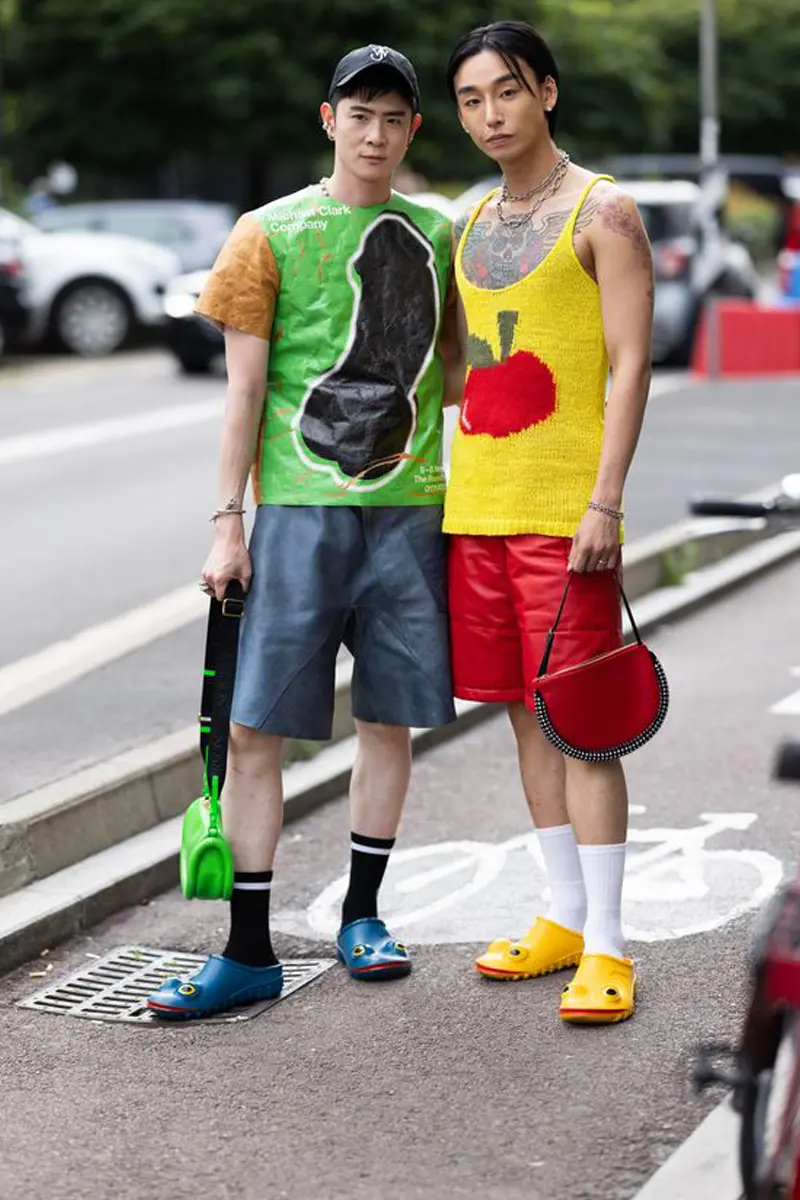Cringe chic is a fashion evolution from Prada’s Ugly Chic. Embracing awkwardness and kitsch, redefining beauty on unconventional terms
The Cringe Chic in Prada’s Ugly Chic in the early 2000s
In recent years, the fashion world has witnessed a trend known as Cringe Chic, which celebrates the unconventional and the ironic. This movement has roots in internet culture and is characterized by its embrace of awkwardness, kitsch, and the unexpected. While Cringe Chic may seem paradoxical, it challenges conventional notions of beauty and style, inviting individuals to embrace their quirks and imperfections with confidence.
A predecessor to the Cringe Chic movement is Prada’s Ugly Chic, a concept introduced by the renowned fashion house in the early 2000s. Prada’s Ugly Chic rejected traditional standards of beauty, opting instead for designs that were deliberately unconventional and even ugly by conventional standards. This aesthetic celebrated imperfection and challenged the notion that fashion must always be polished and pristine.
Miuccia Prada’s origins of Ugly Chic
If a Wildean epigram once immortalized the utterance that «Fashion is a form of ugliness so intolerable that we have to alter it every six months», Miuccia Prada’s work expresses it better than all other fashion designers. Others have toyed with ugliness, with the unpleasant and counter. Balenciaga lost the waist in a sea of fabric while the rest of fashion cinched and corseted in homage to Dior. Christian Lacroix combined shades of beetroot, chartreuse and champagne duchesse-satin, clashing polka-dots and plaid as fashion championed Armani greige. Gianni Versace and Thierry Mugler rigged women in the trappings of the sex shop – a different kind of ugliness, another type of bad taste, but no less questionable. And in the thirties, Elsa Schiaparelli challenged the classicism of Vionnet and the modernism of Chanel with provocation, with dresses delineated by trapunto-stitched ribcages, studded with puckered lips as buttons or tramlined with trompe l’oeil drawers.
Miuccia Prada is an illogical designer. Like the surrealists before her, she questions our subconscious desires. That sounds like heavyweight cant to throw around about a frock-monger, but Prada’s glorification of the anti, the counter and the ugly, is about making us desire what received opinion deems undesirable.
Miuccia Prada’s origins of Ugly Chic
That’s a transgressive notion. Perhaps that’s why perverse is an adjective often applied to Prada. Fashion is about defining taste, separating what is good from what is bad. To be ‘in fashion’ is a validation of an object, a human being, a point of view. To be ‘out’ is a condemnation. What Miuccia Prada has done, throughout her career, is take what would be deemed ‘out’ and make it ‘in’. She has done so more consistently than any other designer in the modern history of fashion. Contrast her with Yves Saint Laurent: what Saint Laurent did was to take these questionable, even ugly styles, and synthesize them into a palatable whole. Saint Laurent sold chic. The clothes Miuccia Prada makes aren’t always chic. They aren’t sanitized, or elegant, or even necessarily attractive. Yet they create a desire. We don’t like them, but we want them.
In 1996, a pair of Prada platform shoes – antiqued leather, with appliques of flowers, in various shades of brown – were judged the ugliest in the world. There were about fifty pairs of these shoes available in the UK and they were completely sold out, immediately. These shoes weren’t nice, they weren’t sexy, and they weren’t like anything else in fashion at that point. Which is perhaps the crux of their appeal.
Behind Ugly Chic – ugliness is entirely relative. Miuccia Prada has played nice: In 1999, she showed a collection she titled Sincere Chic
Jean Baudrillard argued that, in post-modern society, newness is only the simulation of newness – a fashion, for example, is only new in contrast to that which has gone before. No designer has articulated this as perfectly as Miuccia Prada. To eyes accustomed to her ‘Ugly Chic’, her ‘Sincere Chic’ was, paradoxically, ugly. And that ugliness, that arresting contrast to that which has preceded, is what she strives for.
Ugly vs. beautiful. Ugly chic meaning and transformation in Cringe Chic
The temporality of Prada, and of fashion as a whole, is central to Miuccia Prada’s method of working. Unlike comparative designers, there are few obvious signifiers of Prada fashion – in the way that Schiaparelli is associated with the padded shoulder, Lacroix with the poofy skirt, Dior with the cinched waist. Is there a single silhouette that Prada owns? A specific decorative device? No. But that isn’t a criticism. Miuccia Prada’s signature is psychological rather than physical. Her clothing is about discomfort – aesthetic, ideological, somewhat ephemeral. It is ephemeral because the ugliness Prada provokes with this season becomes the new beautiful. Her shifting aesthetics and erogenous zones influence fellow designers and mass-retailers, and sometimes have an impact across the larger realm of popular culture.
Prada’s championing of ugly can be seen as an expression of Susan Sontag’s ultimate Camp statement: it’s good because it’s awful. Prada, however, is rarely Camp – and never sincerely Camp. That’s because there is an artfulness to the ugliness Prada shows us, an intellectual backbone. Her collections are never accidentally in bad taste. Miuccia Prada knows exactly what she is doing – namely, upheaving our aesthetic axes, our idea of what constitutes ‘ugly’ and ‘beautiful’, on a six-month basis.
Prada’s Ugly Chic laid the groundwork for Cringe Chic
Prada’s Ugly Chic laid the groundwork for Cringe Chic, paving the way for designers and fashion enthusiasts to explore the beauty in the unexpected and the unconventional. Like Cringe Chic, Prada’s Ugly Chic blurred the lines between what is traditionally considered unattractive, prompting a reevaluation of beauty standards within the fashion industry. Both movements embrace irony and self-awareness, encouraging individuals to revel in the unexpected and to challenge societal norms through their fashion choices.
While Prada’s Ugly Chic may have set the stage, Cringe Chic has since evolved into a broader cultural phenomenon, extending beyond the realm of high fashion to encompass street style, DIY fashion, and internet memes. It has become a platform for self-expression and social commentary, inviting individuals to embrace their unique identities and celebrate the beauty of imperfection. In a world that often prizes conformity and perfection, Cringe Chic offers a refreshing alternative, reminding us that true style is about confidence, individuality, and a willingness to embrace the awkward.
Cringe Chic, meaning of the word
The term Cringe Chic in fashion refers to a style trend or aesthetic that embraces elements traditionally considered embarrassing, awkward, or uncool. It involves deliberately incorporating fashion choices that might elicit a cringe reaction from others, often with a sense of irony or self-awareness.
Cringe Chic draws inspiration from internet culture, memes, and viral content, reappropriating and elevating what was once considered taboo or tacky into something fashionable and desirable. This trend celebrates imperfection, authenticity, and individuality, challenging conventional standards of beauty and style. Cringe Chic reflects a broader cultural shift towards embracing uniqueness and embracing the humor in human quirks and eccentricities.
What does the term Cringe Chic mean in fashion?
In the world of fashion, trends come and go, but none have captured the collective imagination like the phenomenon known as Cringe Chic. Once relegated to the realm of fashion faux pas, cringe culture has undergone a transformation, evolving from a source of embarrassment to a powerful tool for self-expression and social commentary.
Embracing Awkwardness: The Essence of Cringe Chic
At its core, Cringe Chic is about embracing the awkward, the offbeat, and the unconventional with intellectual irony. It draws inspiration from internet culture, where memes, viral videos, and ironic humor reign supreme.
What was once considered cringe-worthy – think outdated fashion trends, cheesy slogans, or tacky accessories – has been reappropriated and elevated to a new level of coolness. In the age of irony, sincerity is overrated, and embracing the cringe is a badge of honor.
Cringe Chic – Authenticity in an age of perfectionism
But Cringe Chic is more than just a fashion trend; it’s a cultural phenomenon that reflects our complex relationship with authenticity, self-expression, and cultural humor.
In a world saturated with curated images and lifestyles, embracing the cringe is a radical act of defiance – a rejection of polished perfection in favor of raw, unfiltered honesty. It’s about celebrating imperfection and embracing the messiness of life, rather than striving for unattainable ideals of beauty and success.
Democratizing Fashion: The Inclusive Nature of Cringe Chic
One of the defining features of Cringe Chic is its democratizing ethos, rooted in intellectual irony and cultural humor. Unlike high fashion, which can often feel exclusive and elitist, Cringe Chic is accessible to everyone.
It’s about repurposing thrift store finds, DIY fashion projects, and reinterpreting mainstream trends through a lens of irony and irreverence. In the world of Cringe Chic, there are no rules – only endless possibilities for creativity and self-expression.
Subversion and Cultural Commentary in Cringe Chic
An aspect of Cringe Chic is its subversive potential, which stems from its embrace of intellectual irony and cultural humor. By appropriating and recontextualizing elements of mainstream culture, Cringe Chic challenges the status quo and disrupts traditional power dynamics.
It’s a form of cultural resistance – a way of reclaiming agency and asserting individuality in a world that often seeks to homogenize and commodify our identities.
Cultural humor: celebrating Imperfection and Individuality
Cringe Chic represents a bold departure from conventional notions of style and beauty. It’s about embracing the weird, the awkward, and the unapologetically bizarre with a touch of intellectual irony and cultural humor.
In a world that often takes itself too seriously, Cringe Chic reminds us to laugh at ourselves, to embrace our flaws, and to celebrate the messy, imperfect beauty of being human. So go ahead – lean into the cringe, and let your freak flag fly. After all, there’s nothing more fashionable than being authentically yourself.























